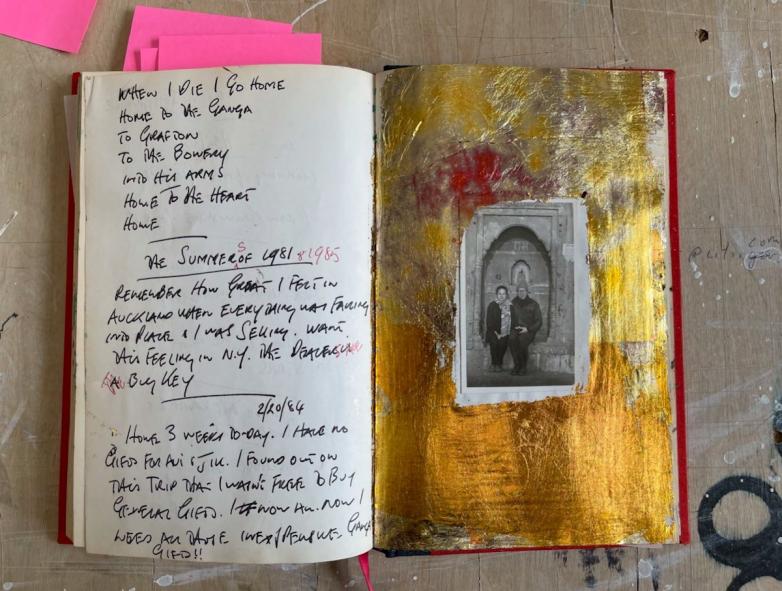Max Gimblett’s Archive of Artist’s Books Joins Getty Research Institute Collection

Max Gimblett, two-page spread from Lord Ganesh Journal, circa 1984. Pencil, ink, collage, and gold leaf gilding, Getty Research Institute.
Los Angeles – The Getty Research Institute has acquired an archive of more than 250 artist’s books. The Max Gimblett Artist’s Book Collection, created by painter, calligrapher, and Zen monk Max Gimblett, are a gift by the artist and his wife, scholar and curator Barbara Kirshenblatt-Gimblett. These volumes join the GRI’s internationally known Artist’s Books Collection.
The stunningly bound volumes are not only unique but notably different from each other. Combining words and images, the journals contain writings, drawings, questions, calculations, small paintings, collages, notes on travel and conferences, and quotes from others. The books document the sources of Gimblett’s work as a self-identified "Pacific Rim person" who grounds his practice, particularly his sumi ink painting, in Zen philosophy.
“Taken together as an archive and including Gimblett’s personal comments and sketches, these artist’s books portray a metaphysical richness of images and ideas,” said Marcia Reed, associate director and chief curator at the GRI. “Far from casual jottings, these are carefully composed, supplemented over time, and specifically dated as the artist returns to them.”
Born in 1935 to a working-class family in Auckland, New Zealand, Gimblett traveled extensively in Europe, before moving to Toronto, Canada, in the early 1960s and apprenticing with Canadian pottery master Roman Bartkiw. There he met his future wife, Barbara Kirshenblatt, and eventually moved with her to Austin, Texas, where she taught at the University of Texas and he held his first solo exhibition at Dave Hickey’s legendary gallery, A Clean Well-Lighted Place.
In 1972, Gimblett and Barbara moved to New York, where he met his mentor, famed New Zealand filmmaker and kinetic sculptor Len Lye. There he began to make what he considers his first mature body of work, the Sacred Geometry paintings and works on paper, and large hard-edge abstract paintings.
Gimblett's practice continued to develop within his books, drawings, and canvases, as he experimented with materials such as silica, acrylic polymers, urethanes, resins, burlaps, linens, and precious metal leaves. In the 1980s, he began making quatrefoil canvases, often gilded to alchemical effect. While the quatrefoil is the hallmark of his shaped canvases, their range has expanded to include shapes of many kinds.
In 1989 Max and Barbara founded Jade Studio to publish unique artist's books and portfolios. For more than 40 years Gimblett has collaborated with artists, writers, and poets, including Robert Creeley, John Yau, Lewis Hyde, and Alan Loney, on drawings, paintings, and unique and limited-edition artist's books.
During the pandemic, as Gimblett was sheltering in his studio where he lived and worked amid his books, he realized that he wished to place the collection as an artist's archive to preserve his legacy for generations to come.
“I began writing and drawing in second-hand books when I was seven years old. Working in sketchbooks and journals has been the consistent and constant thread throughout my life,” he said.
Now housed at the Getty Research Institute, the artist’s books will be cataloged and made available to researchers.















